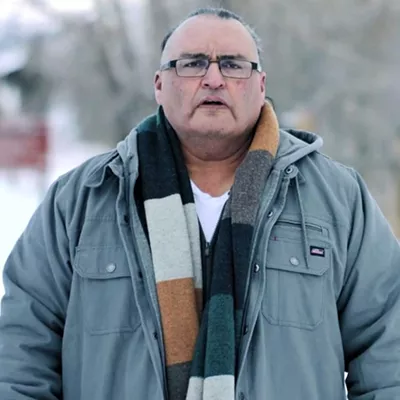"The Owls started in 1886," says Kruse. "In 1899, they moved to the Steinfeld Mansion (300 N. Main Ave.). These were men of power and influence in town. If you had a daughter, you wanted her to meet an Owl. In 1901, they moved to the building called the Owl's Club. At the front of the building, there's a notch at the top, and there's an owl there.
"One out of the 13 men did not marry. He brought in his sister, and she became a hostess," continues Kruse. "The Owl's Club became the place where things happened in the theater and music. ... In the 1930s, the Moose Lodge took over the building. Today, it's a commercial business building."
The story about the Owl's Club, at 378 N. Main Ave., is just one of the interesting tidbits to be heard about Tucson's past. Kruse offers guided walking tours of various parts of Tucson. At 6 p.m. Tuesday, June 7, Kruse leads a "Twilight Walking Tour of the Mansions of Main Avenue." Tour participants should meet at the northwest corner of Main Avenue and Alameda Street. An optional dinner follows at 7:45 p.m. at El Charro. The tour costs $15; dinner is not included. For reservations, call 881-1638. For more information, visit krusearizona.com.
Eight mansions will be discussed on the tour, including the Cheyney House, J. Knox Corbett House and Steinfeld Mansion. But Kruse suggests the word mansion may be misleading. "Use the word with some hesitancy. People back East would not say these are mansions. But when they were built, these were the fanciest places in town. At the turn of the century, these homes cost $10,000 to $15,000. That was a lot of money."
Kruse says there are a lot of fascinating stories about life on Main Avenue. "The movers and shakers of Tucson lived on the north part of Main. Murder, suicide, great story after great story. These people had interesting lives," he says.
One of the movers and shakers of old Tucson was Sam Hughes. "He was called the father of Tucson," says Kruse. "Hughes got here in 1858. He came for health reasons--lung problems. He wanted dry, warm weather. Hughes was involved in practically everything that was going on. He supported free education, built churches ... He did a lot for the town."
In line with the other notable personalities of the time, Hughes had his own interesting story. "In 1864, he was 34 and married a girl who was 12 3/4," says Kruse. "You'll get different stories about her age. Some say 11 3/4, and others say 12 3/4. Her name was Atanacia Santa Cruz. They got married at the San Javier Mission. They didn't go on a honeymoon until 1867. They went to San Francisco and brought back the first Singer Sewing Machine in Tucson (for Atanacia). She became an accomplished seamstress. Hughes had 15 children, with 10 of them living beyond infancy."
Yet another life discussed on the tour is that of John Spring, the second public school teacher in Tucson, from 1872 to 1873. Kruse portrays Spring on all of his walking tours and dresses as him, wearing a bowler hat and boots.
"John Spring is really an interesting character," says Kruse. "He was the most well-educated person in the territory. He wrote a series of articles that were compiled after he died. I needed to find someone who was living at that time who had written some things. ... A friend of mine suggested that I portray him, because I was a teacher. I said, 'This is the character for me.' It worked out really well."
Kruse's teaching background is useful as a tour guide. Kruse taught chemistry at Pima Community College for 28 years before retiring in 2002. He's been a docent at the Arizona Historical Society and did walking tours for the Sosa-Carrillo-Fremont House before starting his own business. "I interact with people and do research on a topic. That's what a teacher loves. People are more interested in history than in chemistry. I don't see why," he laughs.
Kruse also offers walking tours of Armory Park (on Monday, June 13) and of Barrio Historico (on Wednesday, June 29). He says the Barrio is becoming more popular and says that is his favorite tour.
But back on Main Avenue, Kruse says the former residents play a major role in the history of Tucson. Walkers on his twilight tour will "hear a lot of interesting stories, learn about the architecture of the buildings, and see the way Tucson changed before the train came and after. It will give them a sense of what it was like to live here in the 1870s and 1880s."






